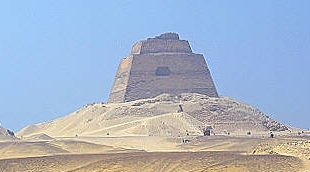Meidum
| Meidum Pyramid | |
|---|---|
 | |
| Type | Step Pyramid |
| Height | 65 metres (213 ft) (ruined) (From base to summit: 93.5 metres (307 ft)) |
| Base | 144 metres (472 ft) |
| Slope | 51°50'35 |

Located about 100km south of modern Cairo, Meidum or Maidum (Arabic: ميدوم) is the location of a large pyramid, and several large mud-brick mastabas.
Pyramid
The pyramid at Meidum is thought to have been originally built for Huni, the last pharaoh of the Third Dynasty. It was completed and probably usurped by his successor, Sneferu, who also turned it from a step pyramid to a true pyramid by filling in the steps with limestone encasing. The Meidum pyramid was built in different stages, beginning as a seven-step pyramid to which an additional step was added at a later stage. It appears to have collapsed sometime during the New Kingdom. A subsidiary pyramid is located on the south side, between the main pyramid and the enclosure wall, and a memorial temple is on its east side.
Known as "the collapsed pyramid", the outer layers of the casing began to collapse, leaving the exposed core showing. Because of its appearance, it is called el-haram el-kaddab — (False Pyramid) in Arabic. Some believe it was the collapse of this pyramid during the reign of Sneferu that led him to change the angle on his second pyramid at Dahshur to 43 degrees. In the fifteenth century, it was described as looking like a five-stepped mountain by al-Maqrizi, gradually falling further into ruin so by the time it was investigated by Napoleon's Expedition in 1799 it had its present 3 steps.
It was excavated by John Shae Perring in 1837, Lepsius in 1843 and then by Flinders Petrie later in the nineteenth century, who located the mortuary temple, facing to the east. In 1920 Ludwig Borchardt studied the area further, followed by Alan Rowe in 1928 and then Ali el-Kholi in the 1970's.
In its ruined state, the structure is 65m high, and its entrance is aligned north-south, with the entrance in the north, 20m metres above present ground level. The steep descending passage 57 metres long leads to a horizontal passage, just below the original ground level, that then leads to a vertical shaft 10 metres high that leads to the corbelled burial chamber itself. It is thought to be unlikely that Sneferu was buried here — whether Huni was may never be known, though construction may have begun during his reign.
Flinders Petrie was the first Egyptologist to establish the facts of its original design dimensions and proportions[1] [2]. In its final form it was 1100 Cubits of 0.523m around by 175 Cubits in height, thus showing the same proportions as the Great Pyramid at Giza, and therefore the same circular symbolism. Petrie wrote in the 1892 excavation report [3] that "We see then that there is an exactly analogous theory for the dimensions of Medum[sic]to that of the Great Pyramid ; in each the approximate ratio of 7 : 44 is adopted, as referred to the radius and circle..". These proportions equated to the four outer faces sloping in by precisely 51.842º or 51º 50' 35", which would have been understood and expressed by the Ancient Egyptians as a seked slope of 5 1/2 palms [4]
Mastabas
Located nearby is a mastaba of an unknown noble, the burial chamber of which can be entered via a robber's tunnel. This tunnel is steep, extremely narrow and confined. Once traversed however, the chamber and hallway are relatively spacious, and contain the first example of a red granite sarcophagus known in antiquity. Another mastaba is the Mastaba of Nefermaat.
The stone sarcophagus remains within the unmarked and undecorated granite built chamber. The tunnel goes further on into the darkness, and as of 2002 remains unexplored.

See also
References
Bibliography
- Lightbody, David I (2008). Egyptian Tomb Architecture: The Archaeological Facts of Pharaonic Circular Symbolism. British Archaeological Reports International Series S1852. ISBN 978-1407303390.
- Petrie, Flinders (1892). Medum. David Nutt: London.
{{cite book}}: Cite has empty unknown parameter:|1=(help) - Edwards, I.E.S. (1979). The Pyramids of Egypt. Penguin.
- Verner, Miroslav (2001). The Pyramids. Their Archaeology and History. Atlantic Books.
- Mendelssohn, Kurt (1976). The Riddle of the Pyramids. Sphere Books Ltd: London. ISBN 0-351-17349-8.
External References
Further reading
- Arnold, Dieter 1991. "Building in Egypt: Pharaonic Stone Masonry" Oxford. Oxford University Press
- Jackson, K & J. Stamp. "Pyramid : Beyond Imagination. Inside the Great Pyramid of Giza"BBC Worldwide Ltd, 2002, ISBN 978-0563488033
